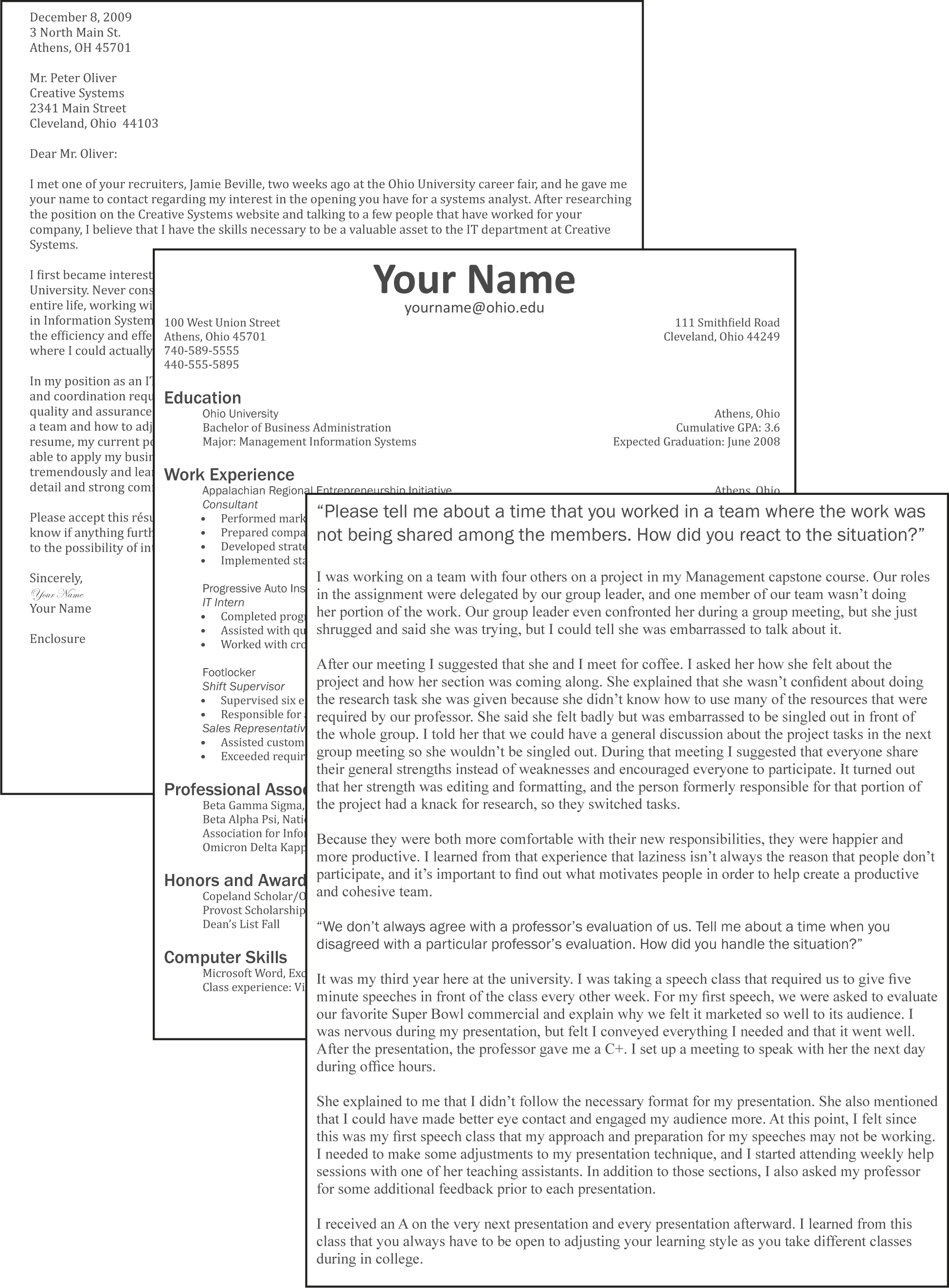This is “Establishing Credentials: Networking and Placement”, chapter 13 from the book Designing Business Information Systems: Apps, Websites, and More (v. 1.0). For details on it (including licensing), click here.
For more information on the source of this book, or why it is available for free, please see the project's home page. You can browse or download additional books there. To download a .zip file containing this book to use offline, simply click here.
Chapter 13 Establishing Credentials: Networking and Placement
13.1 Cover Letters, Resumes, Interviews
Learning Objectives
- Manipulate type and alignment to reproduce a cover letter
- Use design principles to reproduce a resume
- Identify critical elements in cover letters, resumes, and responses to interview questions
- Distinguish between traditional and behavioral based interview questions
- Following design and content principles, create your own resume, cover letter, and responses to interview questions
- Choose and successfully employ MS-Word techniques to solve a complex task
Introduction
There are at least two situations in which you will need to provide a cover letter and resume. One is when applying for a job. However, when you apply for a business loan you may also be asked for a resume. After all the bank wants to gauge whether or not you have the experience and talent to make the business a success.
Your job is to summarize, highlight, and organize your experiences and skills so that it is easy for an employer or loan officer to see what you have to offer. There are guidelines available to help you format your resume and cover letter in an organized and effective manner. Even the most impressive professional experiences can come across poorly if they are displayed on an unorganized resume.
Most of this chapter is written from the perspective of a job search. We have done this so that you will be able to reference the chapter upon graduation to look for a job. However, the same lessons are equally useful in applying for a loan for the purposes of our iPhone assignment.
Initially, employers spend an average of less than one minute looking over a resume, so you need to sell yourself well by having a resume that stands apart from the rest. A resume is your first impression to a potential employer. During a job search, it is the most important tool you can use to get your foot in the door for an interview with a desired employer.
This chapter will provide valuable guidelines to help you create a well-designed and organized resume and cover letter.
Where Are We in the Life Cycle?
Many information systems projects are conceived of in a life cycle that progresses in stages from analysis to implementation. The diagram below shows the stages that we touch in the current chapter:
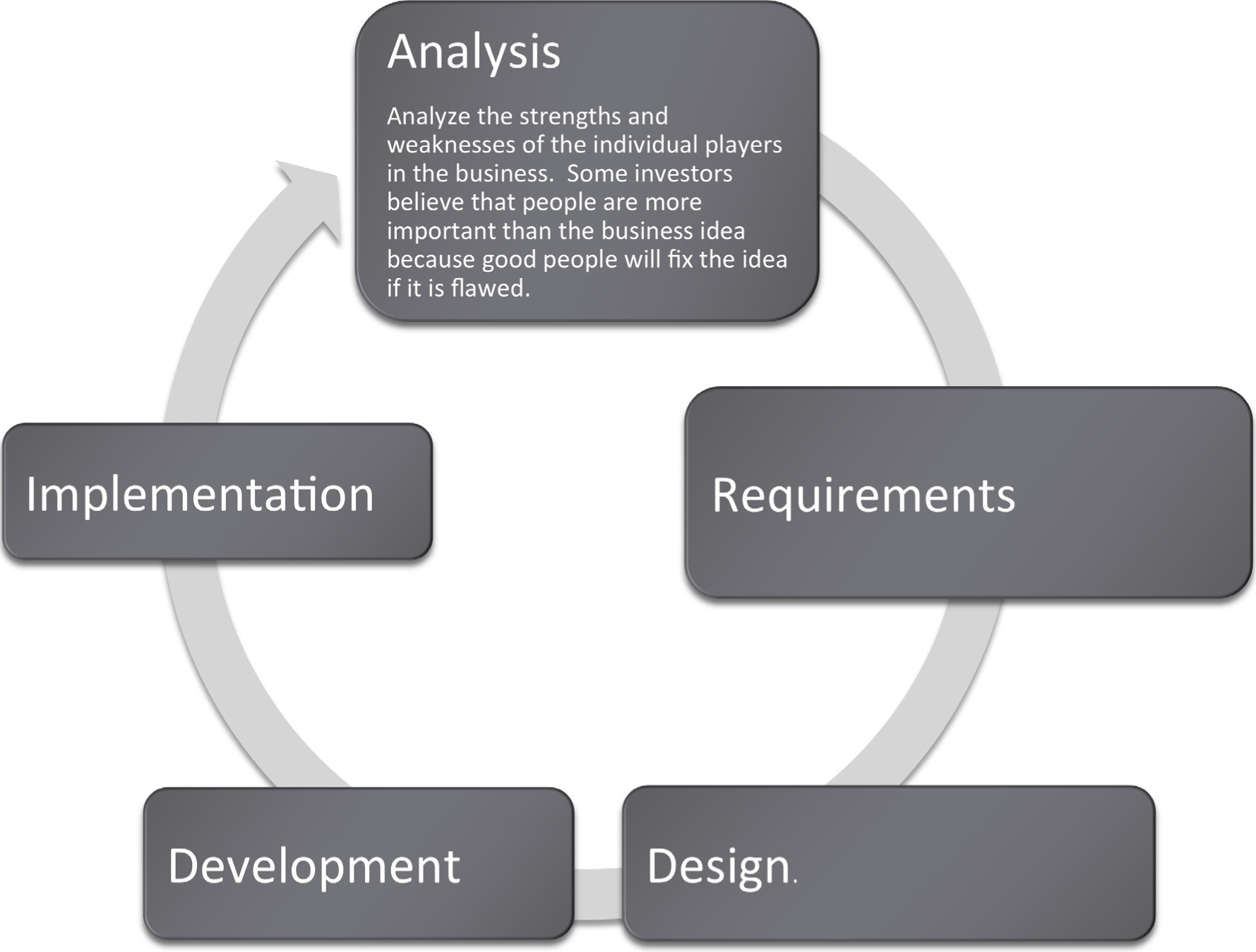
Creating a Cover Letter
When sending a resume to an employer, it is often appropriate to include a cover letter. The purpose of a cover letter is to introduce yourself, explain your reason for contacting the employer, and to sell yourself as a desirable candidate for employment.
Introduction
A cover letter may be your first contact to an employer, or it could be a follow up from a previous meeting. If it is a follow up, remind the employer about your interaction to help him or her recall the original meeting.
Reason for Contact
A cover letter should explain your reason for contacting an employer. There are two types of cover letters: letters of inquiry and letters of application. A letter of inquiry is written when you want more information regarding potential job openings. A letter of application is written when you know specifically which position you would like to obtain and to inform an employer of your qualifications for employment. In both types of letters, you should include information that you already know about the employer and/or position and why you are interested in working for the company. This shows your interest and demonstrates that you have taken the time to research the company.
Sell Yourself
A cover letter should be used to sell yourself more effectively to a potential employer. In a resume, you have limited space to outline yourself and your experiences. In a cover letter, you have much more space to highlight your skills and what you can contribute to the company. You can use the letter to expand upon your best qualities or most important experiences or achievements. You can also emphasize information that directly relates to the position for which you are applying, furthering your chances for consideration. It also allows you to demonstrate your written communication skills.
Writing and Printing a Cover Letter
Cover letters should be personalized and should be prepared individually with each job application. They should be addressed to a specific person, not just a company or department. You can find employee addresses in directories on the company website or through a personal inquiry. CareerSearch®, is a web-based employer research system, and the VAULT Online Career Library are two other ways to research companies and find contact information.
Cover letters should be no more than one page long and should be produced on the same paper as your resume and reference sheet. Also, be sure to double check grammar and spelling to avoid unprofessional errors, and use an organized and neat letter format.
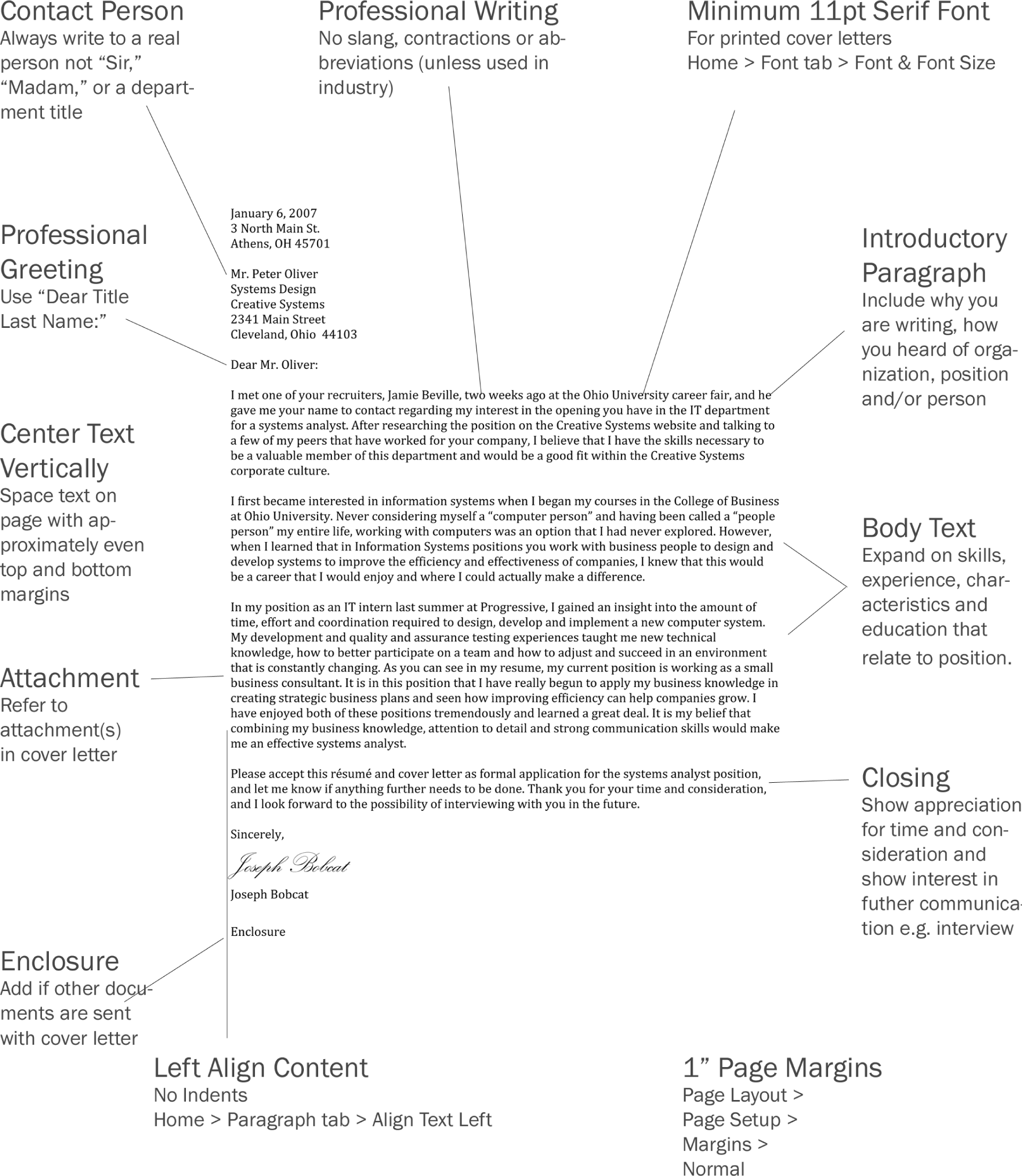
Creating a Resume
A resume is an employer’s first impression of a potential employee. Before you start creating a resume, you will need to gather information concerning your skills and experiences and decide on a career goal.
Content
As you gain career experiences, you will need to update your resume. You may also want to tweak your resume for specific positions for which you are applying to include your knowledge and skills pertaining to that particular job. Though each copy of your resume that you hand out may differ slightly, most resumes need to have the same basic content.
Contact Information
A resume should contain your personal contact information so an employer can reach you for an interview. It should be displayed prominently toward the top of your resume and should include your name, address, phone number, a personal website (if you have one) and an e-mail address. Be sure that you use a professional e-mail address.
Objective
Including an objective on a resume is optional. If you decide not to include an objective, be sure to state this information in your cover letter. An objective should be clear, concise, and should state what you can do for an organization rather than what it can do for you. It should also be updated for each position or employer.
Education
In this section, list all academic information in reverse chronological order with the most recent listed first, including each school you have attended, graduation or expected graduation date, degree(s) earned and major(s), and your GPA (if it is over a 3.0).
Work Experiences
Work experience should also be listed in reverse chronological order and can include any volunteer positions, internships, co-ops, field or practicum experiences, and major class projects. For each listing, include the employer name and location, position title, dates of employment, and at least two points explaining your responsibilities.
Relevant Courses
You may list courses that apply directly to your career goals, but list the full course title rather than the abbreviation.
Activities/Associations
This section should include your extracurricular activities and interests. List any professional organizations, student organizations, athletic teams, or other clubs to which you belong. You may also include any honors or awards you have received or any professional workshops you have attended.
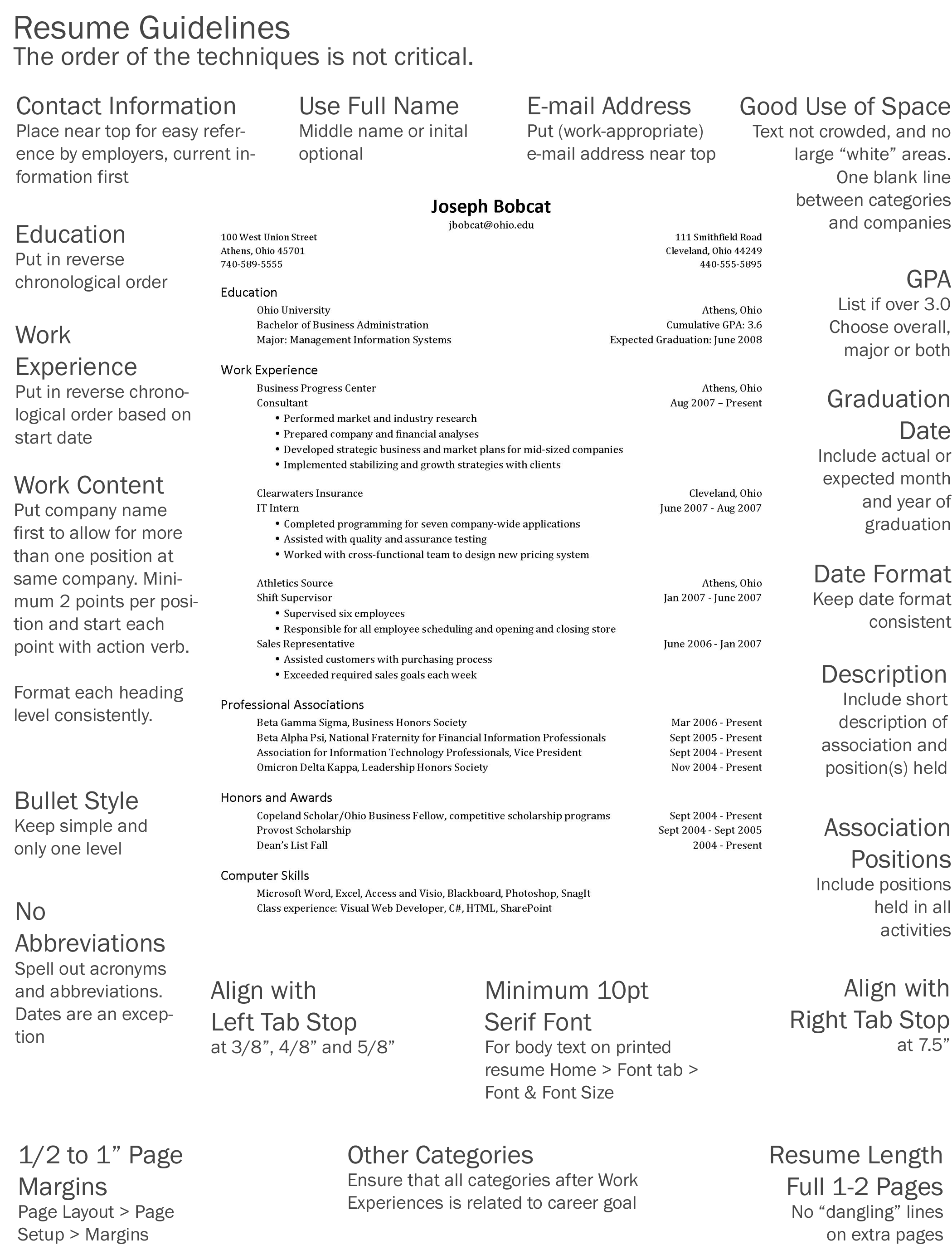
Interviewing Guidelines
Most people are familiar with traditional interviews and can anticipate what type of questions they will be asked in the interview process. Many companies are now using behavioral interview questions in order to discover an applicant’s skills and capabilities.
Traditional Interviews
In a traditional interview, applicants are asked about themselves and their experiences found on their resume. Possible questions include:
- “Please tell me a little about yourself.”
- “What are your strengths and weaknesses?”
- “Why do you think you are the best candidate for this position?”
Behavioral Interviews
In a behavioral interview, the skills and characteristics desired for the chosen employee have already been decided, and the questions that will be asked will be based on those qualifications and will require interviewees to give specific examples of past experiences and how they have handled those situations. This helps the employer see how candidates are likely to perform in similar situations likely to occur in the new position. These questions may be interspersed in conversation or they may be in a set list of questions to be answered. An example question may be, “Describe a difficult problem that you tried to solve. How did you identify the problem and solve it?”
What Employees Look for During an Interview
Employers most commonly look for the following skill sets during an interview:
- Problem solving
- Leadership and teamwork
- Dealing with ambiguity and conflict
- Listening and communication skills
- Showing creativity, assertiveness, and decisiveness
- Demonstrating initiative, and determination
How to Prepare for an Interview
Before an interview, you can prepare by planning to answer possible questions that may be asked. Since no two interviews are alike, it is wise to prepare for both behavioral and traditional interview questions. By reading the position’s description, you can often get a sense of what types of questions will be asked and which of your skills you should be prepared to discuss. Also, be sure to review your resume before an interview to remind yourself of experiences you can talk about with the employer.
Answering Behavior-Based Questions
Employers who ask behavior-based questions want interviewees to describe specific projects, situations, or experiences that can apply to the open position. Before answering a behavior-based question, make sure you understand the question and do not be afraid to ask for clarification if something is vague or unclear. In each response, the interviewer is looking for three main things:
- Problem or situation — describe the context of the situation
- Action — explain what you did
- Result — show the outcome or solution
PAR Examples
By including a problem or situation description, your actions, and a solution in your answer, you can respond to interview questions on PAR. Your responses will help the interviewer understand how you behaved in a certain scenario and determine if you would be a good fit for the open position. Below are two examples of complete and well-structured responses to behavioral interviews questions:
“Please tell me about a time that you worked in a team where the work was not being shared among the members. How did you react to the situation?”
P: I was working on a team with four others on a project in my Management capstone course. Our roles in the assignment were delegated by our group leader, and one member of our team wasn’t doing her portion of the work. Our group leader even confronted her during a group meeting, but she just shrugged and said she was trying, but I could tell she was embarrassed to talk about it.
A: After our meeting, I suggested that she and I meet for coffee. I asked her how she felt about the project and how her section was coming along. She explained that she wasn’t confident about doing the research task she was given because she didn’t know how to use many of the resources that were required by our professor. She said she felt badly but was embarrassed to be singled out in front of the whole group. I told her that we could have a general discussion about the project tasks in the next group meeting so she wouldn’t be singled out. During that meeting, I suggested that everyone share their general strengths instead of weaknesses and encouraged everyone to participate. It turned out that her strength was editing and formatting, and the person formally responsible for that portion of the project had a knack for research, so they switched tasks.
R: Because they were both more comfortable with their new responsibilities, they were happier and more productive. I learned from that experience that laziness isn’t always the reason that people don’t participate, and it’s important to find out what motivates people in order to help create a productive and cohesive team.
“We don’t always agree with a professor’s evaluation of us. Tell me about a time when you disagreed with a particular professor’s evaluation. How did you handle the situation?”
P: It was my third year here at the university. I was taking a speech class that required us to give five minute speeches in front of the class every other week. For my first speech, we were asked to evaluate our favorite Super Bowl commercial and explain why we felt it marketed so well to its audience. I was nervous during my presentation, but felt I covered everything I needed and that it went well. Afterward the presentation, the professor gave me a C+. I set up a meeting to speak with her the next day during office hours.
A: She explained to me that I didn’t follow the necessary format for my presentation. She also mentioned that I could have made better eye contact and engaged my audience more. At this point, I felt since this was my first speech class that my approach and preparation for my speeches may not be working. I needed to make some adjustments to my presentation technique, and I started attending weekly help sessions with one of her teaching assistants. In addition to those sections, I asked my professor for some additional feedback prior to each presentation.
R: I received an A on the very next presentation and every presentation afterward. I learned from this class that you always have to be open to adjusting your learning style as you take different classes during your time at the university.
Key Takeaways
- Interviews may be either traditional or behavioral. A traditional interview normally uses open ended questions that ask you to reflect on your abilities. A behavioral interview asks you to recall how you performed in specific situations. Many businesses are moving towards behavioral interviews on the theory that past behavior is the best predictor of future behavior.
- Answer behavior based questions using the problem, action, result (PAR) method.
- In a world where all resumes look about the same, applying graphic design principles can help your resume and cover letter stand out.
Questions and Exercises
- To what extent do online job posting services such as Monster.com let you preserve the formatting in your resume? Investigate two services and provide results.
Techniques
The following techniques, found in the Word section of the software reference, may be useful in completing the assignments for this chapter: Increase/Decrease Indent • Line spacing • Margins • Ruler • Tab-left • Tab-right • Text-align • Text-bullet • Text-format
L1 Assignment: Cover Letter Design
This exercise also helps you become more familiar with Word and how to format professional documents.
At some point you will apply for a job. You will have to prepare a resume (the L2 exercise). However, for the personal touch often a cover letter is written to accompany the resume.
Setup
Download the file Cover Letter Before.doc from the class web site and save it to your folder. Start MS Word and open the file. Format the given cover letter so that it looks like the “After” example. Use the techniques on the following pages.
Content and Style
Recreate the After example so that your format and alignment is similar to the example.
- Heading and spacing should be the same as the “After” cover letter.
- Fill in any missing elements.
- Add the greeting to the letter.
- Add your name at the bottom and use a script font for your “signature.” In real life you would print out and sign the letter.
- Be sure to use the current date to begin your letter.
Deliverables
Electronic Submission: Submit the “After” cover letter version electronically.
Paper submission: Print the “After”document directly out of Word.
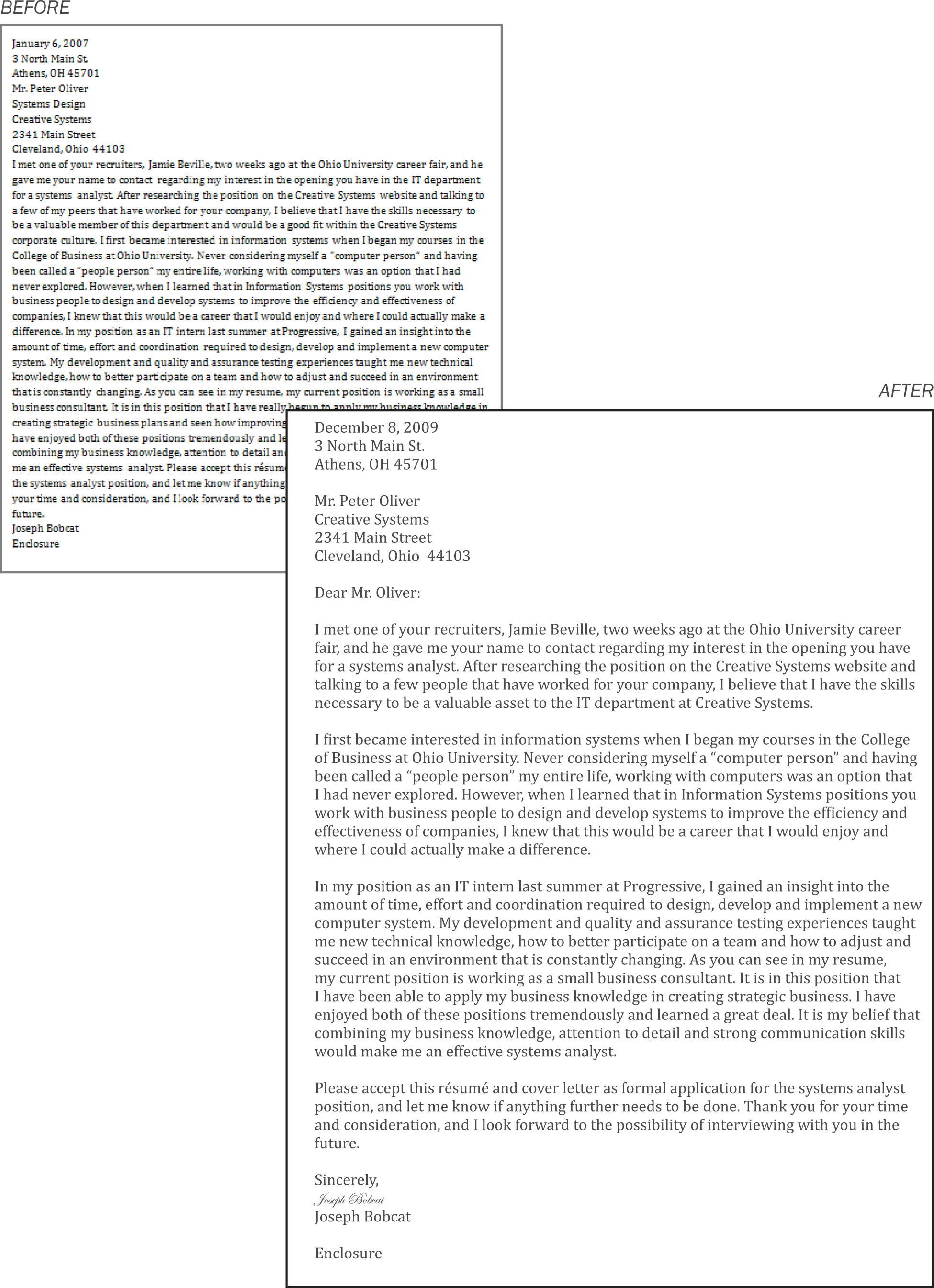
L2 Assignment: Resume Design
This exercise helps make sure that your resume goes in the “good” pile.
Your resume is the number form of communication that you have to apply for a job. It has to be perfect to help present yourself well. Most resumes are viewed for less than a minute by recruiters.
Setup
Download the file Resume Before.doc and save it to your folder. Start MS Word and open the file. Format the given resume so that it looks like the “After” example. Use the techniques on the following pages.
Content and Style
Recreate the “After” example making sure that your alignment and spacing is similar to the example. Each heading level and text should be formatted CONSISTENTLY.
- Add your name and your email address at the top of the page in place of Joe Bobcat’s.
- To start: Set the margins to narrow. Then highlight the entire document (Ctrl + A) and place Left Tab Stops at 3/8″, 4/8″, and 5/8″ and a Right Tab stop at 7.5″. Each time you press the Tab key, the content will move to the next Tab stop.
-
Follow these guidelines for fonts.
- Name: Choose a sans-serif font and make it very large.
- Body text: Choose a serif font.
- Category headings: Same sans-serif font as your name, 2 points larger than body text size, bold.
- School/company name: Same sans-serif font as your name, body text size.
- Position: Same sans-serif font, body text size, italicized.
- Body Text: 10 pt or larger text size, Serif font.
- Make sure there is one blank line between categories and after each employer section.
- Make sure your e-mail address does not become hyperlinked (blue and underlined). If it does become hyperlinked, right click on your e-mail address and select Delete Hyperlink.
Deliverables
Electronic submission: Submit the “After” resume version electronically. It should be only one page.
Paper submission: Create a printout of your “After” resume. It should be only one page.
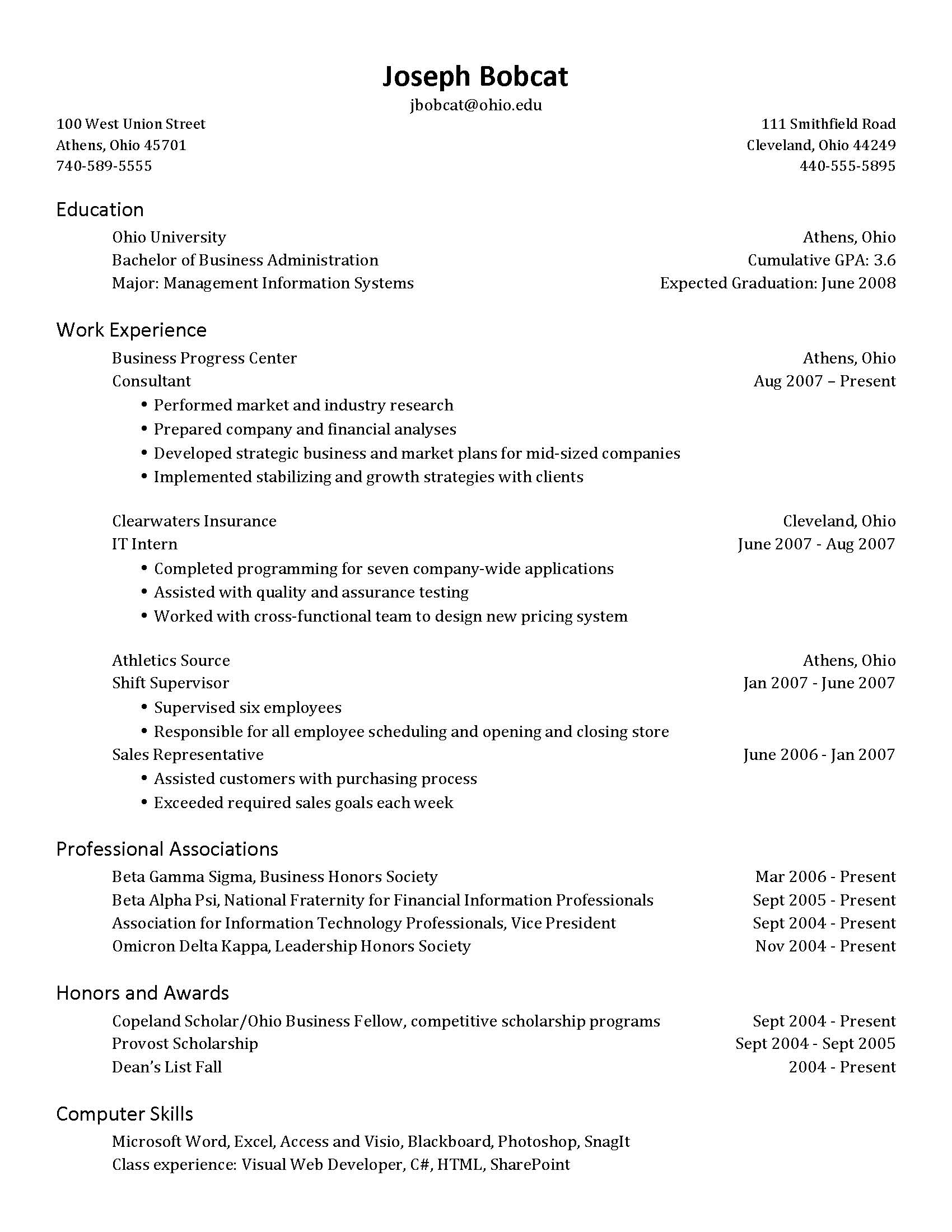
L3 Assignment: Resume, Cover Letter, and Interview
Customize a cover letter, resume, and answer interview questions to prepare for life outside of college.
When you’re out looking for a job, you’ll need a resume (maybe several versions) and likely an individual cover letter for each position for which you apply. It is important that you always keep an updated version of your resume, constantly adding to it each time you get a new job, master a new skill, or anything else that could have an impact on your future career. You will also answer sample behavioral based interview questions in this assignment.
Setup
Create your resume and cover letter in two separate Word documents.
Content and Style
Create a resume and cover letter tailored to your ideal job or internship and answer behavior-based interview questions. You should have your contact information, school details, and work experience on your resume. The other categories that you choose to include are based on your experiences and career goals. You will be graded on both your content and formatting. An additional Word document should be submitted with answers to two behavioral-based questions, which will be graded on your clear and concise use of the PAR method.
- The most important characteristic of your documents is professionalism. Spelling and grammar must be perfect, so make sure you proofread, and have someone else proofread for you.
- Make sure to follow the formatting guidelines from the L1 and L2, although your content will obviously vary from the examples.
- Your resume does not have to be in the same exact layout as the L2, but it should follow all of the guidelines in this chapter.
- You can add and remove categories as your resume content demands.
- You must create your own content for the cover letter. DO NOT COPY THE EXAMPLE IN THE L1. Create your own content in both the resume and cover letter.
- If you only have one address, center align it on the resume
- The cover letter should be addressed to a person. If you don’t know one, make up a name.
- Make sure your e-mail address does not become hyperlinked (blue and underlined). If it does become hyperlinked right click on your e-mail address and select Delete Hyperlink.
-
Please answer any two of the following questions in a separate Word document. Follow the PAR method, and be sure to use your own experiences in your answers.
- Tell me about a skill or technique you learned in school and how you have put that to use in real life.
- How did you make the decision to attend your college or university?
- Tell me about a time when a project was changed after you had already done a significant amount of work. How did you react?
- From a student’s perspective, what is your definition of good performance? What do you do to perform up to that standard?
- Describe a time you made a risky decision. What happened?
Deliverables
Electronic submission: Submit the resume, cover letter (“signed”), and interview answer documents –totaling three separate documents, electronically.
Paper submission: Create a printout of your resume, cover letter, and interview answer document, and sign your cover letter with black or blue ink.
